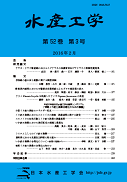Volume 49, Issue 1
Displaying 1-9 of 9 articles from this issue
- |<
- <
- 1
- >
- >|
-
Article type: Article
2012Volume 49Issue 1 Pages 1-12
Published: July 15, 2012
Released on J-STAGE: September 01, 2017
Download PDF (1598K) -
Article type: Article
2012Volume 49Issue 1 Pages 13-20
Published: July 15, 2012
Released on J-STAGE: September 01, 2017
Download PDF (1255K) -
Article type: Article
2012Volume 49Issue 1 Pages 21-25
Published: July 15, 2012
Released on J-STAGE: September 01, 2017
Download PDF (696K) -
Article type: Article
2012Volume 49Issue 1 Pages 27-32
Published: July 15, 2012
Released on J-STAGE: September 01, 2017
Download PDF (1462K) -
Article type: Article
2012Volume 49Issue 1 Pages 33-36
Published: July 15, 2012
Released on J-STAGE: September 01, 2017
Download PDF (1381K) -
Article type: Article
2012Volume 49Issue 1 Pages 37-42
Published: July 15, 2012
Released on J-STAGE: September 01, 2017
Download PDF (11147K) -
Article type: Article
2012Volume 49Issue 1 Pages 43-48
Published: July 15, 2012
Released on J-STAGE: September 01, 2017
Download PDF (1136K) -
Article type: Article
2012Volume 49Issue 1 Pages 49-52
Published: July 15, 2012
Released on J-STAGE: September 01, 2017
Download PDF (918K) -
Article type: Article
2012Volume 49Issue 1 Pages 53-57
Published: July 15, 2012
Released on J-STAGE: September 01, 2017
Download PDF (1464K)
- |<
- <
- 1
- >
- >|
